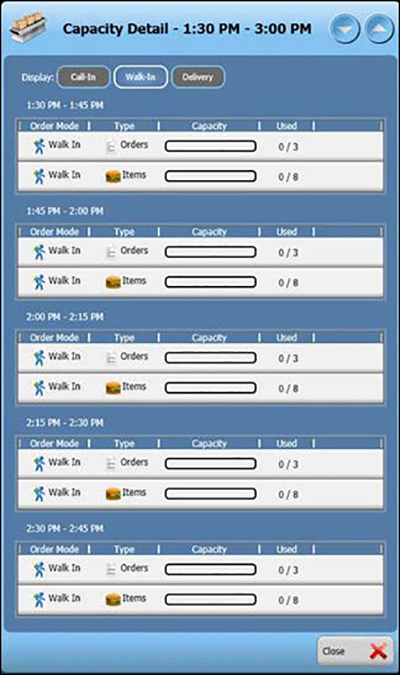Order Scheduling and Capacity Tracking
Core Product: Aloha Takeout
Complimentary Products: Aloha Quick Service, Aloha Table Service
Separate License Required? An Aloha Takeout and Delivery license is required.
Other References: Aloha Takeout Reference Guide, Aloha Takeout Implementation Guide
View/Download/Print: Order Scheduling and Capacity Tracking Feature Focus Guide - HKS371
In the restaurant business, it is important to estimate and monitor how many orders and items your establishment can produce within a specific time of day with consideration to staffing and the length of time it takes to prepare an item. An overload of orders at one time can easily back up the kitchen and the dispatch of delivery drivers, resulting in delayed orders and unsatisfied customers.
In Aloha Takeout (ATO), you can define the time segments that appear on the FOH Future and Dispatch screens according to your operational needs. In conjunction with Order Scheduling, Capacity Tracking enables you to limit the number of future orders or items the system can accept during a defined time segment, reducing the number of customer complaints received as a result of over-committed drivers and kitchen resources. The system manages the available time segments across multiple terminals on a first-come first-serve basis.

In addition, you can use a Capacity Detail button to view an on-screen list of orders for a specific time frame compared to your configured order scheduling limits. When you reach the limit of your defined order capacity, the system prevents you from accepting the order for that time period; however, you can still accept the order for a different order mode or for a different time period. In the event you want to accept an order for the time period in which you have already reached your capacity limit, we recommend you provide an employee, such as a manager, the ability to override the order capacity limit.
FUTURE ORDER SCENARIO: A restaurant determines the kitchen can prepare 25 sandwiches within a 30-minute period and any more would overtax the kitchen and cause orders to be delayed, During the period, a total of 50 sandwiches are ordered for as a future order and passed through Aloha Takeout. The system limits the number of sandwiches you can order to 25; however, if you feel you can handle more, you can override the capacity limitation on demand.
DELIVERY DRIVER SCENARIO: A restaurant schedules two delivery drivers for the lunch shift. Each driver can make two deliveries per 15-minute period, resulting in a total of four deliveries for every 15 minutes. A fifth delivery order would overtax the drivers and could cause orders and delivery runs to be delayed. Setting a limit of four orders for the 15-minute period prevents the system from allowing more delivery orders; however, if you feel you can handle more orders, you can override the capacity limitation on demand.
Configuring Order Scheduling and Capacity Tracking
- Defining your start day, day parts, and tracking limits
- Providing the ability to override capacity limits
- Adding the capacity detail button on ATO FOH screens
- Refreshing POS data